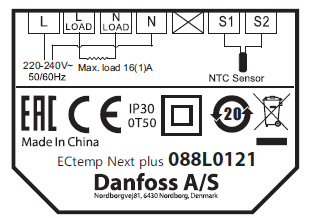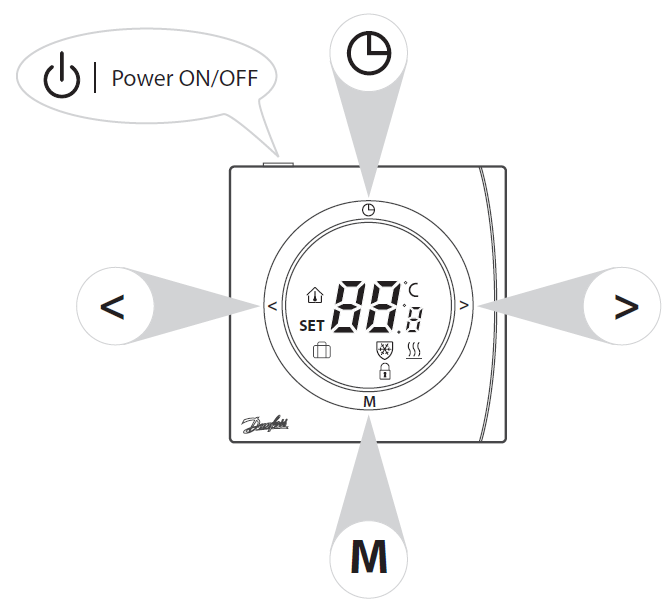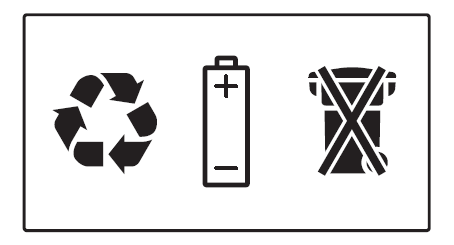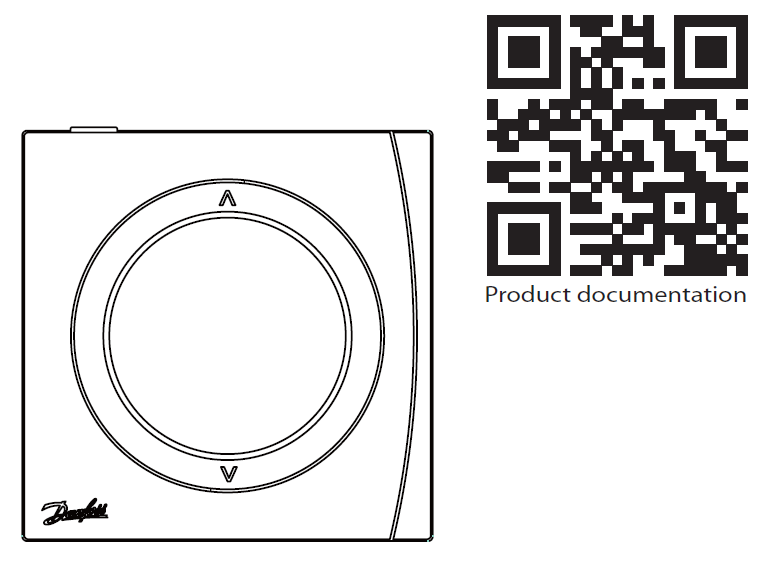Danfoss 088L0121 Electronic Thermostat
Introduction
The Danfoss ECtemp Next Plus is an electronic programmable timer thermostat used for controlling electrical floor heating elements. The thermostat is designed for fixed installation only and can be used for both direct heating of the entire room and for comfort heating of the floor.
Technical Specifications
| Operation voltage | 85-250V~, 50/60 Hz |
| Standby power consumption | 0,4 W |
| Relay: Resistive load Inductive load |
Max. 16 A / 3680 W @ 230 V cos φ= 0.3 Max. 1 A |
| Floor sensor | Floor Sensor NTC 15 kΩ at 25°C |
| Sensing values: (Default NTC 15 K) 0°C
20°C 50°C |
42 kΩ 18 kΩ 6 kΩ |
| Control | Hysteresis ± 1.0° C |
| Ambient temperature | -10°C to +60°C |
| Frost protection temperature | 5°C to +9°C (default 5°C) |
| Temperature range | Room temperature: 5-35°C. Floor temperature: Max. 35°C is default. |
| Sensor failure monitoring | The thermostat has a built-in monitoring circuit, which will switch off the heating if the sensor is disconnected or short- circuited |
| Cable specification max. | 1×4 mm2 or 2×2,5 mm2 |
| Ball pressure test temperature | 75°C |
| Pollution degree | 2 (domestic use) |
| Controller type | 1C |
| Software class | A |
| Storage temperature | -20°C to +65°C |
| IP class | 30 |
| Protection class | Class II – |
| Dimensions | 86 x 86 x 16/40.5 mm (in-wall depth: 24.5 mm) |
| Weight | 103 g |
Electrical safety and Electro-Magnetic Compatibility for this product is covered by the compliance with the EN/IEC Standard “Automatic electrical controls for household and similar use”:
- EN/IEC 60730-1 (general
- EN/IEC 60730-2-9 (thermostat)
Safety Instructions
Make sure the mains supply to the thermostat is turned off before installation
Important: When the thermostat is used to control a floor heating element in connection with a wooden floor or similar material, always use a floor sensor and never set the maximum floor temperature to more than 35°C.
Please also note the following:
- The installation of the thermostat must be done by an authorized and qualified installer according to local regulations.
- The thermostat must be connected to a power supply via an all-pole disconnection switch.
- Always connect the thermostat to continuous power supply.
- Do not expose the thermostat to moisture, water, dust, and excessive heat.
Mounting Instructions
 Place the thermostat at a suitable height on the wall (typically 80-170cm.).
Place the thermostat at a suitable height on the wall (typically 80-170cm.). The thermostat should not be placed in wet rooms. Place it in an adjacent room and use floor sensor only. Always place the thermostat according to local regulation on IP classes and use floor sensor only.
The thermostat should not be placed in wet rooms. Place it in an adjacent room and use floor sensor only. Always place the thermostat according to local regulation on IP classes and use floor sensor only. Do not place the thermostat on the inner side of an exterior wall.
Do not place the thermostat on the inner side of an exterior wall. Always install the thermostat at least 50 cm. from windows and doors.
Always install the thermostat at least 50 cm. from windows and doors. Do not place the thermostat in a way that it will be exposed to direct sunlight
Do not place the thermostat in a way that it will be exposed to direct sunlight Note: A floor sensor enables a more accurate temperature control and is recommended in all floor heating applications and mandatory under wooden floors to reduce the risk of over-heating the floor.
Note: A floor sensor enables a more accurate temperature control and is recommended in all floor heating applications and mandatory under wooden floors to reduce the risk of over-heating the floor.- Place the floor sensor in a conduit in an appropriate place where it is not exposed to sunlight or draft from door openings.
- Equally distant and >2cm from two heating cables.
- The conduit should be flush with the floor surface – countersink the conduit if necessary.
- Route the conduit to the connection box.
- The bending radius of the conduit must be min 50mm.
Connect the thermostat according to the connection diagram.
Symbols
The following symbols appear in the display:



Settings
Power ON/OFF
Switch thermostat ON/OFF by pressing button on top of the thermostat.
Initial Settings
- Initial settings must be specified when the unit is activated for the first time:
- Press M button for 6 seconds to enter the parameter setting mode.
- The upper digits indicate the parameter number.
- Press M for parameter selection.
- Press < or > to set the parameter range. Complete all adjustments.
- Press
 to exit ECtemp Next Plus settings, which is available for this purpose.
to exit ECtemp Next Plus settings, which is available for this purpose. - To exit ECtemp Next settings automatic wait approx. 30 seconds.
The digits indicate the set value as follows
| No� | Parameter settings | Settings range | Default |
| P01 | Working mode | 01: Manual
02: Advanced Program- mable Timer |
02 |
| P02 | Temperature control mode | 01: Room and floor temp; 02: Only floor temp.;
03: Only room temp.* |
01 |
| P03 | Maximum floor temperature | 20-30˚C (only for 01 in P02)** | 35˚C |
| P04 | Frost protection | 01: Enable; 02: Disable | 01 |
| P05 | Frost protection setpoint | 5-9˚C | 5˚C |
| P06 | Timer display option | 01: 24h; 02 12h | 01 |
| P07 | Room temp. display option at shutdown | 01: No display surrent temp.;
02: Display current temp. |
01 |
Advanced Programmable Timer
The Advanced Programmable Timer mode enables the setting of a timer-controlled program for automatic comfort temperature, and an energy-saving lower setback temperature if standard room comfort temperature is not required. The function consists of 2 programs
- P1 with 4 events in 5 days (Mon. Tue. Wed. Thu. Fri.)
- P2 with 4 events in 2 days (Sat. Sun.).
| P1: Press and hold to display Mo. Tu. We. Th. Fr.
P1, Event 1: 1. Use < or > to select the start time. 2. Press to accept the setting. 3. Use < or > to select the temperature. 4. Press to accept the setting.
P1, Event 2-4: Repeat the Event 1 procedure for programming Event 2-4. |
P2: Sa. Su. are now shown in the display.
P2, Event 1: 1. Use < or > to select the start time. 2. Press to accept the setting. 3. Use < or > to select the temperature. 4. Press to accept the setting.
P2, Event 2-4: Repeat the Event 1 procedure for programming Event 2-4. |
Danfoss ECtemp Next Plus
The thermostat will continue the 4-event program based on the present time and day. To set and change the room temperature temporarily:
- Press < or > at any time to change the desired temperature value. SET is shown in the display.
- When releasing the < or >, the display returns to showing the actual temperature. This temperature change is only temporary and will be maintained only until the next programmed setting!
A default program provides timer control if the customer does not create own programs
|
Days |
Event 1 | Event 2 | Event 3 | Event 4 | ||||
| Start time | Temp� | Start time | Temp� | Start time | Temp� | Start time | Temp� | |
| Mon – Fri. | 6:30 | 20˚C
(27˚C)* |
8:30 | 15˚C
(25˚C)* |
16:30 | 20˚C
(27˚C)* |
22:30 | 25˚C
(25˚C)* |
| Sat – Sun. | 7:30 | 20˚C
(27˚C)* |
9:30 | 20˚C
(27˚C)* |
16:30 | 21˚C
(28˚C)* |
22:30 | 25˚C
(25˚C)* |
Temperature Setting
Changing of desired temperature – press < or >. SET is showed in the display. Adjustment is changed in steps of 0.5°C When releasing < or > again the display returns to normal mode and shows actual temperature. It will be possible to set the maximum floor temperature up to 45°C. It would also be possible to use only one temperature sensor. However, this option is not recommendable as this cause an increased risk of overheating of the floor. Extending maximum floor temperature and Setting into room-only mode – See point 4.9 and 4.10. IMPORTANT: When the thermostat is used to control a floor heating element in connection with a wooden floor or similar material, always use a floor sensor and never set the maximum floor temperature to more than 35 ° C.
| Thermal resistance [m2K/W] | Examples of Flooring | Details | Approximate setting for 25˚C floor temperature |
| 0.05 | 8 mm HDF based lami- nate | >800 kg/m3 | 28˚C |
| 0.10 | 14 mm beech parquet | 650 – 800
kg/m3 |
31˚C |
| 0.13 | 22 mm solid oak plank | >800 kg/m3 | 32˚C |
| < 0.17 | Max. carpet thickness suit- able for floor heating | acc. to EN 1307 | 34˚C |
| 0.18 | 22 mm solid for planks | 450 – 650
kg/m3 |
35˚C |
Timer Setting
- To adjust time and week day – press

- Use < or > to adjust hours,
- Press
 again to shift to minutes and use < or > for adjusting3
again to shift to minutes and use < or > for adjusting3 - Press
 again to shift to weekdays and use < or > for selecting right day
again to shift to weekdays and use < or > for selecting right day - Finish timer setting by pressing any other button or wait for automatic exit after 6 sec. without operation
Safety Lock
- Press M and > simultaneous to enable Safety lock.
- To release safety lock press M and > simultaneous again.
Away Mode
- Press M to get into Away mode is
 showed in the display
showed in the display - Changing the desired temperature in Away mode
- Press < or >.
- SET is showed in the display
- Adjustment in steps of 0.5°C
- Press M to exit Away mode again
Present Floor Temperature
- Press M and hold – Press < within 6 sec also start to flash and current floor temperature is being displayed.
- Press any other button to exit or wait for automatic exit after 6 sec. without operation
Change to Room control only
Switch Power OFF
- Press M and Timer buttons simultaneously for approx. 10 seconds
- Select Function P08: Only Room temperature control
- Select Setting 01: Enable
Switch Power ON
- Press M button for approx. 6 seconds
- Select Parameter Setting P02: Temperature Control mode
- Select Setting Range 03: Room Only mode
Extending Maximum floor temperature limitation to 45°C
Power OFF
- Press M and Timer buttons simultaneously for 10 seconds into those parameters setting.
- Select Function P07 (Table in 4.11): Setting range extension for P06, P07 and P08
- Select Setting 02: Maximum 45°C
- Adjust Maximum Floor temperature according to need up to 45°C
Power ON
- Press M button for 6 seconds
- Select P03 (Table in 4.2): raise floor temperature limitation higher than 35°C by using the >
Table for 4.9 Change to Room control only and 4.10 Extending Maximum Floor temperature limitations to 45°C
| No. | Function | Setting | Factory default |
| Danfoss ECtemp™ Next Plus | |||
| P01 | Room Sensor Calibration | Offset:-10˚C to
+10˚C |
0˚C |
| P02 | Floor Sensor Calibration | Offset:-10˚C to
+10˚C |
0˚C |
| P03 | Maximum Room Temp. Limitation | 5-35˚C(Active in Temperature Control Mode 01) |
35˚C |
| P04 | Minimum Room Temp. Limitation | 5-35˚C(Active in Temperature Control Mode 01) |
5˚C |
| P05 | Maximum Room Temp. Limitation | 5-35˚C(Active in Temperature Control Mode 02) |
35˚C |
| P06 | Minimum Room Temp. Limitation | 5-35˚C(Active in Temperature Control Mode 02) |
5˚C |
| P07 | Setting range extension for P06, P07, P08 | 01: Max. 35˚C, 02:
Max. 45˚C |
01 |
| P08 | Only room temperature control | 01: Enable, 02: Disable |
02 |
Error Codes
| E1 | Room sensor failure |
| E2 | Floor sensor failure |
| EE | EEPROM failure |
| Lo | Temperature lower than 0˚C |
| Hi | Temperature higher than 5˚C |
Warranty
Disposal Instruction
Danfoss ECtemp Next Plus
- Intelligent Timer Thermostat
- Floor / Room Sensor
- 85-250V~
- 50-60Hz
- -10°C to +60°C
- 16A/3680W@230V~
- IP 3
Danfoss
- Danfoss A/S
- Electric Heating Systems
- Ulvehavevej 61
- 7100 Vejle
- Denmark
- Phone: +45 7488 8500
- Fax: +45 7488 8501
- http://electricheating.danfoss.com/
REFERENCE
DOWNLOAD MANUAL
Danfoss 088L0121 Electronic Thermostat Installation Guide





Leave a Reply